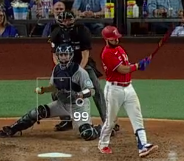Emmanuel Clase Is One of a Kind
Take a gander at the list of the most effective relievers in the majors thus far and you get a mix of known quantities and pop-up guys. That’s the nature of the beast. When evaluating relievers, we deal with small samples and given the talent of any major league pitcher, many have the ability to place atop a leaderboard over a short span of time.
| Name | Team | IP | K% | BB% | GB% | pLI | FIP- |
|---|---|---|---|---|---|---|---|
| Aroldis Chapman | NYY | 15 | 57.4 | 9.3 | 38.9 | 1.51 | 1 |
| Josh Hader | MIL | 15.2 | 45.9 | 11.5 | 19.2 | 2.11 | 21 |
| James Karinchak | CLE | 17.1 | 53.2 | 8.1 | 30.4 | 1.56 | 28 |
| César Valdez | BAL | 16 | 28.6 | 4.3 | 45.7 | 2.69 | 34 |
| Paul Fry | BAL | 15.1 | 37.3 | 10.2 | 64.3 | 1.66 | 35 |
| Ryan Pressly | HOU | 18 | 29 | 4.3 | 63 | 1.26 | 36 |
| Matt Barnes | BOS | 20.1 | 49.3 | 4.2 | 39.4 | 1.73 | 36 |
| Richard Rodriguez | PIT | 17 | 24.1 | 1.7 | 30.2 | 1.58 | 40 |
| Kendall Graveman | SEA | 16.2 | 29.3 | 5.2 | 45.9 | 2.01 | 46 |
| Scott Barlow | KCR | 21 | 31.9 | 9.9 | 40.4 | 1.62 | 46 |
| Josh Sborz | TEX | 17 | 28.2 | 8.5 | 53.3 | 1.12 | 47 |
| Dylan Floro | MIA | 18.2 | 22.4 | 5.3 | 47.3 | 1.94 | 49 |
| Edwin Díaz | NYM | 15.1 | 30.2 | 7.9 | 36.1 | 1.44 | 50 |
| Craig Kimbrel | CHC | 15.2 | 41 | 11.5 | 27.6 | 2.38 | 52 |
| Aaron Bummer | CHW | 15.1 | 29.2 | 10.8 | 76.3 | 1.45 | 55 |
| Jimmy Nelson | LAD | 16.2 | 35.2 | 15.5 | 38.2 | 1.61 | 56 |
| Will Smith | ATL | 16 | 28.6 | 11.4 | 31.7 | 2 | 57 |
| Blake Treinen | LAD | 16.2 | 30.1 | 6.8 | 60 | 1.78 | 58 |
| Drew Steckenrider | SEA | 17 | 29.4 | 11.8 | 56.4 | 0.79 | 60 |
| Taylor Rogers | MIN | 15 | 33.9 | 3.2 | 43.2 | 2.13 | 61 |
| Emmanuel Clase | CLE | 18 | 23.2 | 11 | 72.2 | 1.75 | 63 |
| A.J. Minter | ATL | 17.2 | 26 | 11.7 | 43.5 | 2.16 | 63 |
| Giovanny Gallegos | STL | 23.1 | 29.1 | 5.8 | 35.3 | 1.17 | 64 |
| Mark Melancon | SDP | 18.2 | 21.7 | 4.3 | 68.6 | 2.16 | 67 |
| Phillips Valdez | BOS | 15.1 | 24.2 | 9.7 | 61.5 | 0.5 | 69 |
Readers of this website are almost certainly aware of strikeout artists Aroldis Chapman, Josh Hader, James Karinchak, Craig Kimbrel, and Edwin Díaz. We also see familiar faces Ryan Pressly, Blake Treinen, Taylor Rogers, Mark Melancon, and Will Smith. César Valdez shows up here and is especially notable given his velocity, changeup usage and journey, which has included stops across MLB organizations, Taiwan, and Mexico. Matt Barnes is having a resurgent season. Giovanny Gallegos has been incredibly effective since he arrived in New York after he was part of the trade that sent Luke Voit to the Yankees. But today I want to focus on Emmanuel Clase. Read the rest of this entry »

